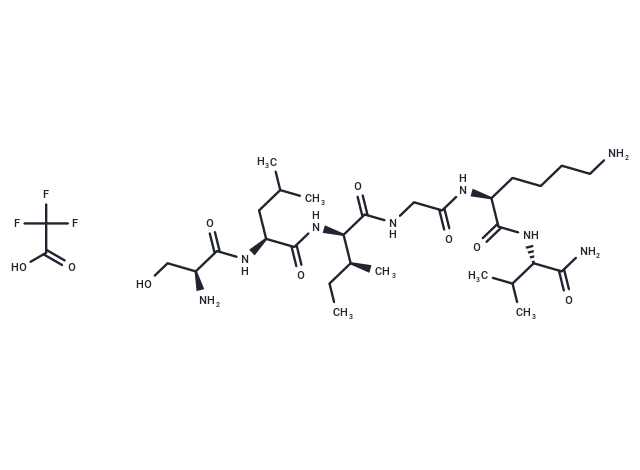- Remove All
 Your shopping cart is currently empty
Your shopping cart is currently empty
PAR2 (1-6) amide (human) (trifluoroacetate salt)
PAR2 (1-6) amide is a synthetic peptide agonist of proteinase-activated receptor 2 (PAR2) that corresponds to residues 1-6 of the amino terminal tethered ligand sequence of human PAR2 and residues 37-42 of the full-length sequence.1It binds to NCTC 2544 cells expressing human PAR2 (Ki= 9.64 μM in a radioligand binding assay) and induces calcium mobilization in the same cells (EC50= 0.075 μM).2PAR2 (1-6) amide (100 μM) reduces colony formation of A549 lung cancer cells.1It induces superoxide production and degranulation in isolated human eosinophils when used at a concentration of 500 μM.3PAR2 (1-6) amide (5 μmol/kg) induces tear secretion in rats when used in combination with amastatin .4

PAR2 (1-6) amide (human) (trifluoroacetate salt)
| Pack Size | Price | Availability | Quantity |
|---|---|---|---|
| 5 mg | Inquiry | 35 days | |
| 10 mg | Inquiry | 35 days | |
| 25 mg | Inquiry | 35 days | |
| 50 mg | Inquiry | 35 days |
Product Introduction
| Description | PAR2 (1-6) amide is a synthetic peptide agonist of proteinase-activated receptor 2 (PAR2) that corresponds to residues 1-6 of the amino terminal tethered ligand sequence of human PAR2 and residues 37-42 of the full-length sequence.1It binds to NCTC 2544 cells expressing human PAR2 (Ki= 9.64 μM in a radioligand binding assay) and induces calcium mobilization in the same cells (EC50= 0.075 μM).2PAR2 (1-6) amide (100 μM) reduces colony formation of A549 lung cancer cells.1It induces superoxide production and degranulation in isolated human eosinophils when used at a concentration of 500 μM.3PAR2 (1-6) amide (5 μmol/kg) induces tear secretion in rats when used in combination with amastatin .4 1.Bohm, S.K., Kong, W., Bromme, D., et al.Molecular cloning, expression and potential functions of the human proteinase-activated receptor-2Biochem. J.314(Pt 3)1009-1016(1996) 2.Kanke, T., Ishiwata, H., Kabeya, M., et al.Binding of a highly potent protease-activated receptor-2 (PAR2) activating peptide, [3H]2-furoyl-LIGRL-NH2, to human PAR2Br. J. Pharmacol.145(2)255-263(2005) 3.Miike, S., McWilliam, A.S., and Kita, H.Trypsin induces activation and inflammatory mediator release from human eosinophils through protease-activated receptor-2J. Immunol.167(11)6615-6622(2001) 4.Nishikawa, H., Kawai, K., Tanaka, M., et al.Protease-activated receptor-2 (PAR-2)-related peptides induce tear secretion in rats: Involvement of PAR-2 and non-PAR-2 mechanismsJ. Pharmacol. Exp. Ther.312(2)324-331(2005) |
| Alias | PAR2 (1-6) amide (human) (trifluoroacetate salt) |
| Molecular Weight | 728.812 |
| Formula | C30H55F3N8O9 |
| Cas No. | 2379569-17-0 |
| Storage | keep away from moisture | Powder: -20°C for 3 years | In solvent: -80°C for 1 year | Shipping with blue ice. | |||||||||||||||||||||||||||||||||||
| Solubility Information | Ethanol: 5 mg/mL (6.86 mM), Sonication is recommended. DMF: 30 mg/mL (41.16 mM), Sonication is recommended. DMSO: 15 mg/mL (20.58 mM), Sonication is recommended. PBS (pH 7.2): 10 mg/mL (13.72 mM), Sonication is recommended. | |||||||||||||||||||||||||||||||||||
Solution Preparation Table | ||||||||||||||||||||||||||||||||||||
Ethanol/PBS (pH 7.2)/DMSO/DMF
PBS (pH 7.2)/DMSO/DMF
DMSO/DMF
| ||||||||||||||||||||||||||||||||||||
Calculator
In Vivo Formulation Calculator (Clear solution)
Dose Conversion
Tech Support
Keywords

Copyright © 2015-2025 TargetMol Chemicals Inc. All Rights Reserved.




